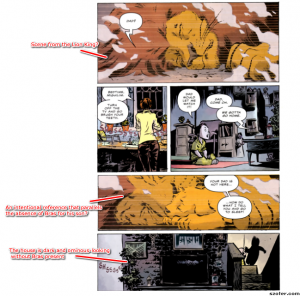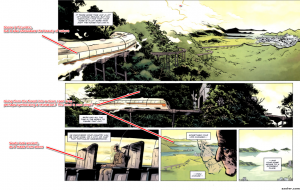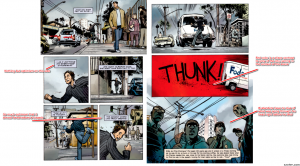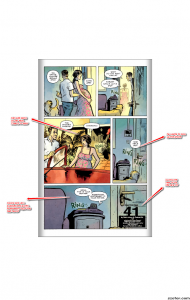Last Friday, Augmenting Realities entered the Makey Makey Makerspace…
Using Makey Makey, with each student as a unique directional keyboard input, they together created this gif using only the Makey Makey device and coordinating hand-touching.

Daytripper is an amazing piece of art. There are many things that we can explore including the art effect of using water color and the existentialist’s theme and what not.
One important thing that impacts me greatly after annotating the graphic novel is that the graphic novel does a better job in expressing emotions that cannot be expressed as words. Some of the annotations I chose would appear funny if they were depicted verbally. Most prominently, quietness is the most well depicted scenario among all the ineffable situations, which leaves the reader plentiful room for personal interpretation. However, this will at the same time unlikely let the reader misinterpret the emotion (unless the creator sucks at drawing) because the readers can absorb other information from the frame or the adjacent frames. A smile, a frown or a distant frame of what is happening tips the reader off about the emotion related to the story, while vividly revokes the reader’s past experience. This is the power of graphic novel (and manga) that enables it to surpass a text-based novel. When someone is reading a graphic novel, the story happens right in front of the reader’s eyes, not in the back of her mind. Lots of things go on without explaining in a graphic novel, just as life goes on without anyone explaining the details. This perk leaves the reader a realistic representation of a life story. My annotations will explicate this further.
The first chapter:
The last scene of the second chapter:
After his wife received the message that her husband is dead in chapter 8:
Chapter 9, after the protagonist wakes up from a long dream:
Daytripper portrays a story of life, a story of reality, a story filled with genuine emotions humans are subjected to experience. The creators of this comic, Fabio Moon and Gabriel Ba, know how to express human relationships and the way they affect the people involved. Every frame exposes the feelings each individual felt through important events in the protagonist’s life.
In this frame, the mother of the protagonist tells the son that his child is born. The background helps set the mood of the event.
In this frame, the father is talking to his son about books. He is expressing his love for them and he is grasping his father’s take on why he writes.
This frame shows the ending of their relationship. She is upset at the fact that she wasted so many years on him, and now she has made a final decision to leave him.
This frame happens after the Brazilian woman leaves him. He feels left in the dark, forced to take in the realization that he has lost the woman he loved.
Moon, Fábio, Gabriel Bá, Dave Stewart, and Sean Konot. Daytripper. New York: DC Comics, 2011. Print.
I had never read a graphic novel until this past weekend. I loved reading Daytripper by Ba and Moon, because it was an easy and short read, but it conveyed so much more emotion than most books that I have read. Discussing the novel in class, the thing that resounded with me the most was the use of vivid colors by Ba and Moon. I noticed that the protagonist, Bras, did not have the most expressive reactions, but the set background is what gave each scenario life. The way that Ba and Moon strategically used the contrast of colors in between scenario or chapters was extraordinary. For example, the author rarely used bright red, but the bar scene in which both Bras and the bartender are shot at point blank is completely red. As a reader, all the red is very overwhelming and really heightens the reader’s senses, essentially transferring the character’s emotions off the page. In the scene, Bras’ face expression is pretty dull, not because he is bored, but because he is basically frozen. The loud red is what reveals that sentiment without needing to overly focus on the face expression of Bras in a graphics perspective.
Another color that Ba and Moon use in transferring emotion is the color black. When there is a lot of black within the scene, Ba and Moon are trying to create a sense of urgency or mystery. The scene where Bras goes to search for his best friend, Jorge, the deliberate black in the scenes reveals desolation and the character’s journey for answers. Jorge had just told Bras that he is going to do something with his life because he is tired of where he is at. Bras immediately hears this and craves the need to try and help him or talk to him. The urgency or desperation in Bras is revealed by the dark color tones as he is driving towards Jorge. These examples demonstrate how ingenious Ba and Moon were in their efforts to making this graphic novel very compelling to the reader.
The beauty of Daytripper is in its ability to encapsulate universally-relatable aspects of human nature and jarringly powerful emotions in its short, simple scenes. Ba and Moon are masters of shedding light on the human condition, and through the tangled arrangement of vignettes that make up Bras’s life they are highly effective in creating an emotional connection with readers.
For example, the scene in Chapter 2 where Bras and Jorge overlook a canyon captures humans’ indescribable wonder at nature’s beautiful creations. The two young men can neither describe the view with words (all that Bras can say is “Wow…” (Moon 36)) nor capture the moment with a picture. Most people have experienced the feeling of trying to take a picture of something beautiful and finding that the picture is inadequate, and Ba and Moon do an excellent job of displaying this sense of awe.
Another scene, where Bras’s son watches TV while his father is gone in Chapter 8, is powerful in demonstrating the emotional importance that parents have for their children. The scene appears to reference Disney’s The Lion King, when the death of Mufasa leaves his son Simba alone. This also foreshadows the later death of Bras (which is not much of a surprise by this point in the graphic novel).

In Chapter 9 an elderly Bras rides the train alone through a mountainous region. Bras has been doing a lot of thinking, and he comes to a sort of revelation while riding the train. Ba and Moon use the passage of the train from the forest into a clear region with excellent views to show the epiphany that Bras has had in clearing his mind. The scene also presents an interesting contrast between the natural beauty of the landscape and the futuristic elegance of the train.

Arguably the most heartbreaking death in the graphic novel occurs at the hands of the truck in Chapter 3. Bras has suddenly become intoxicated with the enchanting possibilities of life, and is literally sprinting to take advantage of all that the world has to offer him. All of this is wiped out in an instant by the truck, and the illustration of the death has an unforgettable blood-red color scheme. For Bras to be so hopeful and optimistic and to have it all sniffed out by a random accident certainly provokes a strong emotional reaction, and reminds all readers of the reality of human mortality and the fleeting nature of life.

Works Cited:
Moon, Fábio, Gabriel Bá, Dave Stewart, and Sean Konot. Daytripper. New York: DC Comics, 2011. Print.
The Lion King. Walt Disney Pictures, 1994. Film.
Daytripper by Ba and Moon may just be one of the coolest things I’ve ever read. I have never read a graphic novel before, and it has been ages since I’ve picked up a picture book, so I forgot how much pictures can add to a novel. When going through and annotating my spreads, one thing that really stood out to me was how Ba and Moon focused on color and facial expression to really supplement the story line and add an element that just isn’t possible with a plain text novel. For example, the spread where Bras is learning about his father’s passing. In the first panel, we see Bras leave the hospital and find his mother outside, so we know where the scene is taking place. However, after that, Ba and Moon choose to remove the background details altogether, so all we see is Bras and his mother on a solid colored background. This forces us to focus only on their interactions and not be distracted by what’s happening in the scenery. Then, the scenery slowly transforms from yellow to blue as the scene unfolds. The colors are a reflection of Bras’ emotions—it starts off as yellow, surprise that his mother is here at the hospital, and then slowly blue is added as Bras senses that something is not right and his mood shifts form surprise to shock, and finally when he learns of his father’s passing, he is on a pure blue background, pure, unaltered sadness. Additionally, the focus on facial detail is incredible. Ba and Moon do an incredible job of highlighting the character’s facial features, especially their eyes. It is said that eyes are the best way to express emotion, and in the panel where Bras finally gets the news of his father’s death, the sorrow and shock in his eyes is undeniable—as an artist, I can attest to the level of skill necessary to illustrate such emotion. Each spread works in a similar way, as can be shown by the side notes on the annotated panels
I think all of these things, these simple yet powerful enhancers to the novel are all testaments to the allowances of graphic novels, and by showing the action, Ba and Moon make the text speak more to the audience than if they had simply described the scenes. This novel demonstrates that a picture is indeed worth a thousand words.



Moon, Fábio, Gabriel Bá, Dave Stewart, and Sean Konot. Daytripper. New York: DC Comics, 2011. Print.
Gabriel Ba and Fabio Moon’s Daytripper is truly a work of art. It is a meditation on mortality, a book of life lessons, a uniquely crafted biography of an obituary writer named Bras, a roller coaster of emotions, and much more. The graphic novel is broken into 10 important periods, in non-chronological order, of Bras’ life. At the end of each piece Bras always dies in one way or another, be it from a heart attack, a car crash, a shooting, or something completely unexpected like a peaceful ocean ceremony. Below, I recount four quick scenes of the novel.
This scene is taken from the end of chapter 2, where Bras falls in love with a beautiful Brazilian woman while on a trip with his best friend Jorge in Brazil. Strangely enough, Bras was having dreams of a woman that may or may not parallel his love interest before and after meeting her. Here, his dream women his foretelling where his actual love interest wants him to do. Unsurprisingly, he ends up dying on that beach.
This scene is taken from the following chapter, 3. In it, he is shown to have recently broken up with the woman he met in Brazil, and he is heart broken. However, the above picture is part of perhaps the most romantic scene in the book – his “love at first sight” moment. It is also an excellent example of the kind of deeply moving scene that the authors and Ba and Moon are capable of – both in its text and pictures.
Jumping forward, the above scene comes from chapter 6. It depicts probably the most gruesome and surprising scene in Daytripper. Throughout the graphic novel, we discover the depth of the friendship of Bras and Jorge. They spent college together, went on trips together, worked together, etc. When Jorge inexplicably left Bras to go live elsewhere, Bras often wrote postcards to him. Wanting to meet with his friend after being a part for so long, Bras goes out in search of him. After finally finding him, Bras discovers him in a very low place. Jorge then unexplainably murders Bras and commits suicide, apparently out of his very degraded mental state. Daytripper captures the emotions of both characters excellently in the above scene.
This scene comes from the very last chapter of Daytripper. Here, Bras has become very old, and he goes to the beach this night seemingly to take his own life. This isn’t because of any deep depression he was going through; he had spent this day in the loving company of his wife and children. Rather, it might have been triggered by a letter written by his father. In it, his father wrote that he was proud of Bras for not needing him anymore, and that one can only “let go” when one accepts that one will die. Perhaps Bras was finally in the state where he could let go.
Works Cited
Moon, Fábio, Gabriel Bá, Dave Stewart, and Sean Konot. Daytripper. New York: DC Comics, 2011. Print.
When the “cloud” and Internet appeared into the world, there was great debate as to how to classify or label this medium for communication and information. Many individuals, like Barlow suggested that cyberspace was separate from the material world and that the typical “legal concepts of property, expression, identity, movement, and context do not apply to [cyberspace]. They are all based on matter, and there is no matter here” (Blanchette 4). This approach to network data from the tech industry and its leaders such as Amazon and Google promoted a divergence from the material, in the hope to place digital information and networking on a pedestal above all else. Of course these tech companies want to brand the cloud in this manner because it places their valuable digital information (revenue generator), into an “untouchable” land where typical regulations and laws are a blur. The interesting part is that the false advertisement of data on an immaterial level is not hard to achieve. As we discussed in our recent seminars, the idea of a cyberspace with digital data was something that was envisioned many years ago. This idea was portrayed in many sci-fi movies and futurist shows, such that when we look up cyberspace in Google, we find bizarre photos that do not resemble anything close to what data centers look like.
This means that the general public assumes that cloud space, to be an immaterial one. This implies that the reality of a material perspective of the Internet and networked digital systems is the alternate view rather than the principle one. In personal reflection, I knew that the cloud was not really in a “cloud”-like space, floating in the immaterial, but looking at the pictures of the Google Data Centers and looking at hardware components solidified that reality in a harsh way. For example, I did not know about the wired tunneled underneath the Atlantic Ocean, I just figured that they wired it some how, but I always kept it in the back of my mind and just thought of “Wi-Fi” when I would Skype with someone abroad. My natural instincts to simplify my view of digital networks overshadowed logical and reason. This is a common occurrence and to change the general perspective of the digital network to a material one would be extremely difficult.
Even though it is a challenge, after processing the readings for this week, I think that the material in the digital needs to be recognized. It is a necessity, not because a running imagination is a bad thing, but that grounding the digital space to the material will also link the digital to the same laws and regulations that other mediums face. This is absolutely necessary because the more we allow digital data to become “untouchable”, the more access siren servers, like Amazon and Facebook, have to power and money.
Blanchette, Jean-Francois. “A Material History of Bits.” Web. 10 Oct. 2014. http://polaris.gseis.ucla.edu/blanchette/papers/materiality.pdf
Sorry that I am not able to make it to class today, but I am going home early! However, I am uploading some of the results I received for my Facebook analytics.
Out of all the information the Wolfram shared about my profile, I thought the friend connect map was the most impressive! I thought that it was very indicative of my social circles. Essentially, I have two large groups and it makes a lot of sense because one of them is my high school circle and the other is my Duke University social circle. It was great to think about that going back home, because I never really thought about the divide between the two until looking at this connection map and it really impacted me. I never thought about how related my friends are to each other and Wolfram was able to summarize my social circle in about 10 seconds.
The other interesting interpretive graphic that I connected with a lot was the word frequency chart, where surely enough, DUKE and BOLIVIA were some of the most used words in my status posts. I thought that the chart was pretty accurate, and that it didn’t use just status posts but also comments I made in various Facebook groups and photos, so the Wolfram Analytics was very thorough in this regard.
Lastly, I am posting my Facebook bot that produced something pretty random but very funny:
Going to TC and to sleep at Strathmore at the Hispanic Alliance for education reception I’m on my way they run with my sis and and then stay in ARGENTINA this summer!!
-DiegoBot

A medium that is able to analyze the thoughts you put out into the world constitutes as data tracking. Sometimes this is beneficial. By tracking the data of individuals, the government is able to track down the mood of the nation. Also, it is able to find individuals who are planning to threaten the peace. But because data can be utilized to threaten society, privacy rights where established in an attempt to set boundaries and diminish problems. Then, through the development of various programs, data reading applications were born. These apps such as PrivacyFix, Wolfram, and Tweet Report, synthesize our data in order to show us our Internet footprint. These types of apps are quantified as data tracking due to their nature of grasping our information and regurgitating it back to us in more simplistic forms. Regardless of whether this sounds creepy or not, we allowed them to go into our history in order to bring back to our present the data trends we put out into the internet. In retrospect, this can be considered type of way humans think alongside technology, since without our help, technology wouldn’t have had the ability to create this. In other words, technology needs us as much as we need technology. Through these types of experiences we are able to see on a broader perspective, how we present ourselves to the world through the Internet. A great example is the amount Privacy Fix calculates in order to show us how much we are worth to companies like Facebook. Clearly, such companies are making revenue from our activity, but we as well benefit from their functions. Those 18 dollars Facebook makes through my activity may seem insignificant, but considering they possess a large audience, it is clear how it became a multimillion-dollar company. Thinking about the way we affect data and how data affects us provides us with more awareness of the way we affect this multidimensional cyberspace filled with an almost infinite amount of information.
Powered by WordPress & Theme by Anders Norén